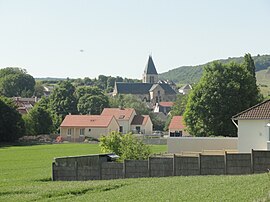Avenay-Val-d'Or
Avenay-Val-d'Or | |
|---|---|
 A general view of Avenay-Val-d'Or | |
| Coordinates: 49°04′12″N 4°02′48″E / 49.07°N 4.0467°E | |
| Country | France |
| Region | Grand Est |
| Department | Marne |
| Arrondissement | Épernay |
| Canton | Épernay-1 |
| Intercommunality | CC Grande Vallée Marne |
| Government | |
| • Mayor (2020–2026) | Philippe Maussire[1] |
Area 1 | 12.49 km2 (4.82 sq mi) |
| Population (2022)[2] | 961 |
| • Density | 77/km2 (200/sq mi) |
| Time zone | UTC+01:00 (CET) |
| • Summer (DST) | UTC+02:00 (CEST) |
| INSEE/Postal code | 51028 /51160 |
| Elevation | 73–256 m (240–840 ft) |
| 1 French Land Register data, which excludes lakes, ponds, glaciers > 1 km2 (0.386 sq mi or 247 acres) and river estuaries. | |
Avenay-Val-d'Or (French pronunciation: [avnɛ val dɔʁ]) is a commune in the Marne department, northeastern France. Located in the Vallée de la Marne, part of the Champagne region, its primary industry is viticulture.

History
A number of Roman remains have been discovered nearby, including a fort and medals showing Emperors Marcus Aurelius and his son Commodus. It was formerly the site of a Benedictine abbey founded by Bertha of Avenay at the end of the sixth century CE, later destroyed during the French Revolution.[3] One of the most prestigious religious institutions in Champagne, it became so popular in the 12th century that limits were placed on the number of nuns accepted.[4]
Population
| Year | Pop. | ±% p.a. |
|---|---|---|
| 1968 | 1,009 | — |
| 1975 | 1,040 | +0.43% |
| 1982 | 953 | −1.24% |
| 1990 | 991 | +0.49% |
| 1999 | 1,026 | +0.39% |
| 2009 | 920 | −1.08% |
| 2014 | 956 | +0.77% |
| 2020 | 1,008 | +0.89% |
| Source: INSEE[5] | ||
See also
References
- ^ "Répertoire national des élus: les maires". data.gouv.fr, Plateforme ouverte des données publiques françaises (in French). 2 December 2020.
- ^ "Populations de référence 2022" (in French). The National Institute of Statistics and Economic Studies. 19 December 2024.
- ^ "Bertha of Avenay (fl. 6th c.); Women in World History: A Biographical Encyclopedia". Encyclopedia.com. Retrieved 25 June 2019.
- ^ Evergates, Theodor (1999). Aristocratic Women in Medieval France. University of Pennsylvania Press. p. 104. ISBN 978-0812235036.
- ^ Population en historique depuis 1968, INSEE



